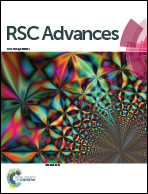Selective sorption and subsequent photocatalytic degradation of cationic dyes by sonochemically synthesized nano CuWO4 and Cu3Mo2O9†
Abstract
Sorption of harmful organic pollutants from industrial effluents and their concomitant photodegradation by the sorbent under visible light can be an effective method for wastewater remediation. In this work, we report the facile synthesis of CuWO4 and Cu3Mo2O9 nanoparticles via a simple sonochemical approach. The materials exhibit superior selective sorption of cationic dyes. The uptake of cationic dyes like rhodamine B (RhB), methylene blue (MB) and malachite green (MG) have been studied along with their adsorption kinetics. The sorption plots have been fitted to various isotherms and the results have been discussed in detail. Removal of the dye from the sorbent has been carried out via mechanical agitation as well as via photocatalysis. The dye sorbed nanosorbents have been subjected to photocatalytic degradation under visible light and they show promising results. The sorbents can be completely removed from the system by simple centrifuging. The reusability of the sorbents has also been tested and they have been found to retain their efficiency after several consecutive runs. Thus, these materials show promise as effective remediators for industrial dye effluents.


 Please wait while we load your content...
Please wait while we load your content...